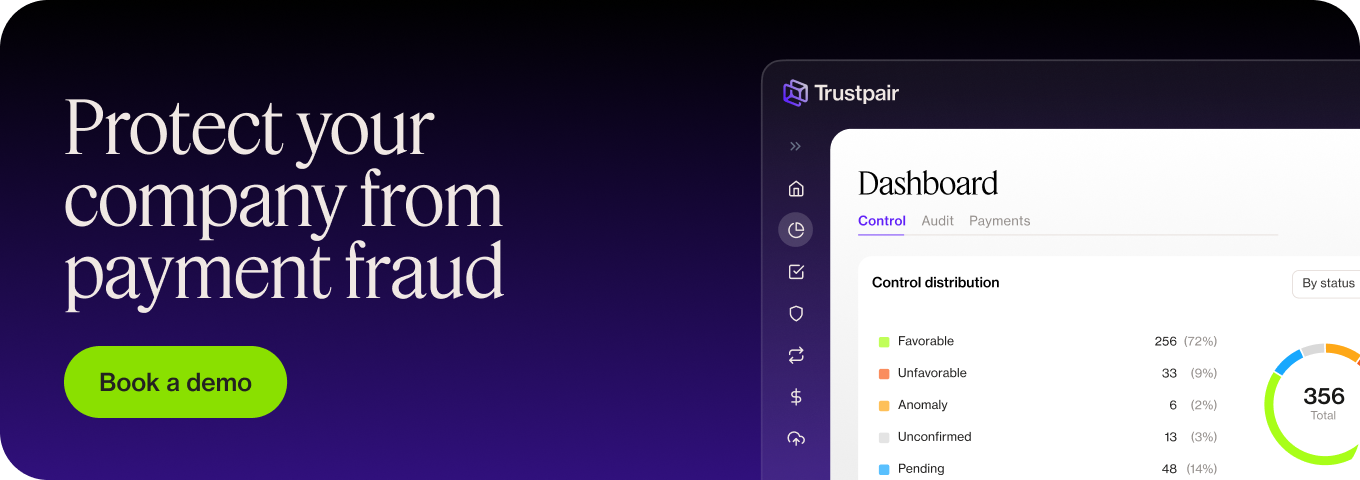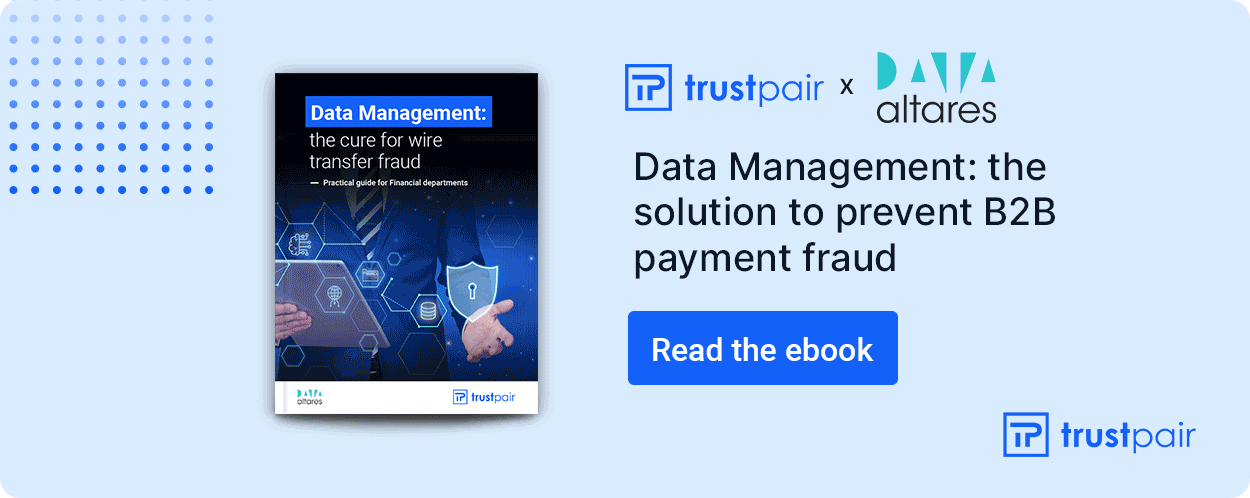Poor vendor management cost the Charlotte County judicial system over $6 million in wasted fees. The organization tried to transform its operations but failed to perform due diligence properly. Without verifying their suppliers and maintaining proper vendor database records, they paid a supplier who disappeared, losing the entire amount to payment fraud. Read on for more explanations in this article.
Maintaining your vendor database is incredibly important, and Trustpair’s technology can help. We continuously control third-party data to make sure your money doesn’t fall into the wrong hands. Contact an expert to learn more!
What is a vendor database?
A vendor database is a place to keep records about all your business’ suppliers, merchants, and third parties. It’s typically found online and provides a centralized dashboard for team members to access the information they might need.
There are several types of records that could be found within a vendor database, and this largely depends on the size and needs of the organization. Examples of basic data categories include company name, contact details, product information, minimum order quantities, pricing, and payment terms. The database grows each time you register a new partner.
It’s important to note that the quality of data is much more important than volume. It should be relevant, and the whole business depends on the reliability of this information.
Depending on the industry and products, vendor databases might also include data on certifications, regulatory or compliance requirements such as ultimate beneficial owners, environmental impact, and more. If supplier diversity is important for your business, working with minority or women-owned businesses could also be a good column to add.
Here is an example of what a basic vendor database could look like:
| Data Set | Vendor A | Vendor B |
| Contact details | contact@vendorA.com | hello@vendorB.com |
| Product / service | Bottles | Cans |
| Price per unit | $0.15 | $0.08 |
| Minimum order quantity | 10,000 | 1,000 |
| Payment terms | Net 30 days | Net 90 days |
| Early payment discount? | 5% discount within 14 days | no |
| UBO | Mr A Name | Miss B Name |
| SOX Law compliant? | yes | no |
What are the benefits of having a vendor database?
Vendor databases are useful in order to keep track of contact details, ensure payment meets the deadline, and provide an overview of supplier information. With around 15 million employees affected by third party fraud in 2022 – maintaining a vendor database is absolutely critical for companies. Even if most supplier information is public and can be accessed easily online, it’s more efficient to centralize it.
Generally, it’s much easier to use a vendor data management system than to search through email threads to try and find the information previously agreed on. Plus, if more than one team member is involved in finding and negotiating with suppliers or making purchase orders, vendor databases provide a centralized location for the information everybody may need.
However, vendor databases can also be advantageous in other areas. For example, by being able to check payment terms, a company could benefit from early payment discounts.
Or, by integrating a vendor database with inventory software, businesses can automate their purchase requisition forms when product numbers go below a certain threshold. Therefore, they’re an opportunity to transform parts of the business with automation and increase overall efficiency.
Finally, maintaining vendor databases helps to avoid both mistakes, and financial fraud. Control third party data with a centralized vendor management system instead of scattered information, and protect against payment fraud while doing so.
What are the benefits of maintaining your vendor database?
The average vendor database management system can cost between $4,000 and $40,000, which is a huge range. When enterprises make such a large investment, they should ensure the database is maintained properly, to:
- Optimize operational efficiency
- Increase revenue
- Avoid payment fraud and vendor fraud
Optimize operational efficiency
Operational efficiency refers to how well an organization works in all aspects to complete its daily operations. This encompasses everything, from finding a new supplier to how each department communicates with another, for example.
Vendor databases help to streamline daily operations because they create an easy-access resource that’s available for each team member. But keeping them maintained, rather than stagnant, streamlines efficiency even further. It means that team members can easily find new or updated information within a vendor’s account themself, instead of wasting the time of colleagues.
If the vendor database isn’t maintained, all the data could be altered or become obsolete. Instead, ongoing attention allows teams to find information upfront, without having to back-and-forth with the merchant themself. This reduces frustrations between supplier and receiver, as well as allows a business to maintain good relationships while managing third parties.
Increase revenue
Vendor databases, underpinned by the right software, are brilliant for automating parts of the sales process. Operating with a well-maintained vendor database could lead to easy integration with third party systems, such as an inventory management system. Of course, this requires up-to-date information for the automation of purchase orders, products and invoice settlements.
So how exactly does this increase revenue?
By cutting the time between product orders, to facilitate quick scaling, and automating purchase orders to reduce manual hours (and their wages). Plus, businesses can benefit from early payment discounts by leveraging a maintained vendor database. That’s because all of the payment information is instantly available, removing barriers to early payment.
Vendor databases that integrate and automate are able to streamline processes and reduce uneccesary expenses. In fact, automation has been proven to increase efficiency by 66% in businesses.
Avoid payment fraud
Vendor databases are also beneficial for protecting businesses against payment fraud. If you can be sure that the information within the database is up-to-date, you’ll be able to compare any payment request or change of credentials request directly with the data. It’s easy to pay vendors with peace of mind and avoid the threat of wire transfer scams.
Imagine receiving a payment request from a supplier for a specific amount. By referring to an accurate database, you’ll be able to check that this account is actually the right one and that the payment details match up. This allows you to disregard the threat of phishing emails, spoofing or any other payment threats.
Many of the vendor platforms available actually track who logs in when, and who makes changes. It makes it easy for auditors to follow the bookkeeping, and for investigators to determine the perpetrators of internal payment fraud. This can form as part of a wider data governance policy to further protect the business.
How can you maintain your vendor database?
Maintaining a vendor database involves regularly auditing it, updating it, and using the data for the business’ advantage. But it doesn’t have to waste more of your employees’ time on manual and repetitive tasks. Instead, automation is key.
Update it regularly
Updating your vendor database is a key part of its maintenance. This means changing the contact details when an employee is replaced or updating the prices with inflation.
Any given company might have thousands of vendors who could each make a few changes per year. Therefore, finding an automated way to handle these changes is much more efficient (and less costly) than manually.
Moreover, a tool like Trustpair can be used to enrich the data by centralizing several external data sources. This ensures that data remains accurate, even without human input.
Regular audits
Auditing the vendor database is important for fraud prevention and information accuracy. Checking supplier information only when you register a new one isn’t enough. In fact, controls should be led consistently throughout the whole lifecycle.
The best way to automate this is through the use of software that works continuously to validate the information. Best-in-class solutions like Trustpair are able to verify and enrich your supplier information in real time.
Imagine: a fraudster attempts to impersonate one of your vendors and sends an invoice but with different bank account details.
Without automated oversight, your team may believe the ruse and pay into the new account. However, Trustpair audits supplier information against global data sources to validate requests for payments. And, it happens in real time, preventing any money from leaving your organization’s account if suspicious or unknown third parties are detected. Our platform based on machine learning will help you manage your risks globally and increase your performance in fraud prevention.
Download our dedicated white paper to learn all the best practices about data management!
To recap…
A vendor database is an online management system for the supply chain, useful for when procurement is contracting suppliers for solicitation (bidding) and sourcing new merchants. Accounts payable use the vendor database to optimize the supply chain, increase revenue, and prevent fraud, using automation solutions like Trustpair.
Our services also include comprehensive analytics and cutting-edge technology to streamline financial risk management in mid-market and enterprise-size companies. Customer support is available at all time to help you tackle any performance issue you might have with the tool and we integrate directly with many other solutions like Oracle or SAP.






